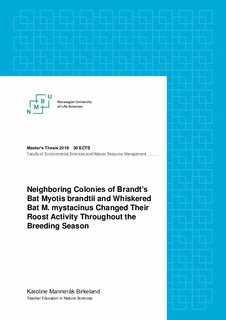| dc.description.abstract | Little is known about bats in Norway, although they constitute > 20 % of our terrestrial mammal species; 13 bats species are registered, but it is not known if all of these reproduce in the country. Many European bat populations are in decline, probably due to factors like environmental contamination, habitat loss and fragmentation, changes in human land use and disturbance at roosts and hibernacula. Female bats form social colonies in the breeding season and can use several roosts that are spatially aggregated. This clumped distribution can make them particularly vulnerable to disturbances and habitat changes. Thus, more knowledge about maternity roost ecology, dynamics and behavior is needed for evidence-based management and conservation.
The goal of this study was to monitor colonies of two bat species in southeast Norway throughout the breeding season, to increase our understanding of seasonal variation in bat activity. Furthermore, I wanted to investigate if bat activity at and nearby the maternity roosts, was linked to climatic factors such as temperature, humidity and light.
I monitored one colony of Brandt’s bats Myotis brandtii and one colony of whiskered bats M. mystacinus, which both consisted of several roosts. We counted number of bats flying out from the roosts and passing through nearby vegetation corridors several times throughout the breeding season, and we logged echo localization calls every night. Additionally, we monitored temperature, humidity and light continuously throughout the same period at two roosts.
I found that (1) time of first emergence varied throughout season for both species, and was also influenced by temperature; (2) there was a positive relationship between bat activity at the roosts and temperature in the beginning of the season; (3) individual bats changed roosts during the breeding season; (4) there was a difference between colonies of M. brandtii and M. mystacinus in number of bats exiting the roosts and type of vegetation corridor that was used most frequently.
Long term research and monitoring of environmental conditions is important to determine if the roosting behavior of M. brandtii and M. mystacinus observed in this study – and the differences observed between the two species - are indeed typical patterns which can inform management. In particular, it would be important to find out whether individuals of M. brandtii and M. mystacinus normally change roosts during the breeding season, or if that is a response to unusual environmental conditions in the year of the study. | nb_NO |

